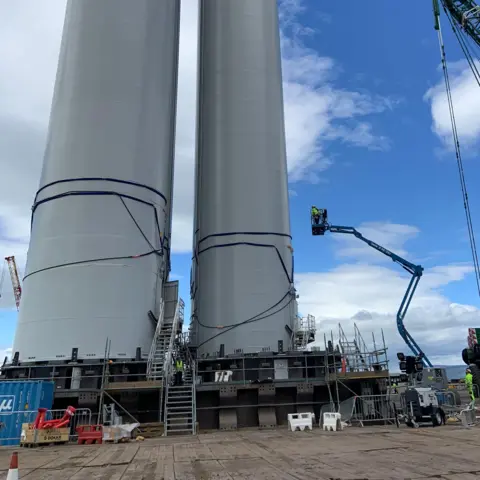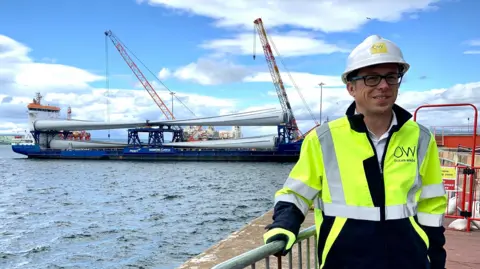 BBC
BBCOne of Scotland’s most powerful offshore wind farms has connected to the grid for the first time and is on target to produce enough power for half of Scotland’s homes.
Moray West is located as close as 22km from Helmsdale in Sutherland and 50km north of Buckie.
Nearly a third of its 60 turbines have been installed, and all the platforms on which the turbines sit.
The total project is costed at £2.5bn. Ocean Winds, its developer, is based in Madrid, and is co-owned by Portuguese and French energy firms.
Its power cable has landfall at Sandend near Portsoy in Aberdeenshire.
It has been buried under ground for 27km to a newly-built substation, near Keith, and Moray West then feeds power into the national grid at nearby Blackhillock sub-station.

Raising the finance was helped by Engie, one of the parent companies, contracting with Amazon and Google to supply the energy they need for operations including data centres.
The project involves the biggest turbines yet installed in British waters, each spinning up to 257m (843ft) above sea level.
The 17th and 18th turbines are being installed this week, while work continues at the Nigg quayside facility in Easter Ross to assemble the steel towers. These stand 120m (393ft) tall. The gear box, or nacelle, weighs 700 tonnes and sits on top of the tower.
The three blades on each turbine are 108ms (354ft) long, and these are being shipped to the Easter Ross assembling yard from the Siemens-Gamesa factory in Hull.
The turbine towers sits on monopiles or single steel tubes. Made by Smulders Projects at Wallsend in North Tyneside, these have been sunk 30 metres into the seabed, with a 60-metre rise to the surface of the North Sea.
A further major part of the project are the seabed cables linking the turbines with each other and with the Moray coast. These were made in Hartlepool by JDR.

Ocean Winds has published its analysis on the economic impact for Scotland and for the UK economy, saying there are more than 80 UK suppliers in construction and installation.
Developers such as Ocean Winds are under pressure from governments and regulators to boost their supply chain procurement close to home.
The Moray East windfarm, in a sea area that borders Moray West, is reckoned to have brought 6000 worker years to the UK and £550m of value added, with Moray West on track to reach similar numbers.
Once the windfarm is operating, however, there are only 70 maintenance jobs attached to Moray West, based out of Buckie. Its operations are monitored from Glasgow.
The same number of workers are operating out of Fraserburgh to service the Moray East windfarm, which is already in operation.
While Moray East has 100 turbines, rated at 9.5MW, the newer designs being installed at Moray West are rated at 14.7MW, so the newer array produces a similar amount of power with 40% fewer turbines to install.

The scale of engineering in the biggest turbines now on the market is astonishing. These are turbines designed to withstand the worst of Scotland’s sea and weather conditions so that they can harvest the power of the wind.
The pressures on such big structures are hard to comprehend. The turbines reach higher above sea level than Arthur’s Seat in Edinburgh. They are twice the height of Scotland’s highest free-standing building, the Glasgow Science Centre Tower.
Ambitions for the offshore wind sector are also colossal. Connecting Moray West is due to be followed by a fast-expanding programme of offshore wind. Ocean Winds has rights to a bigger sea area in the outer Moray Firth that it’s working on, and then it moves on to floating wind turbines.
But having got the engineering right, there are other obstacles.
The industry has been set back in the past two years by the cost of finance going up sharply, and by other cost inflation. Among the bottlenecks in the supply chain is availability of specialist vessels equipped with large cranes to install turbines.
The one shuttling between Moray West and Nigg in Easter Ross, carrying two turbines each time and taking around a week to install them, has to be booked two to three years in advance.

Getting the installation contractors in place follows years of planning and design, as well as securing a guaranteed floor price through an auction process run by the energy regulator Ofgem, and then winning a consent to link into the national power grid.
That grid is constrained by a lack of capacity to get power from the north of Scotland to the central belt and then on to England’s cities and beyond. Only when there is enough cable capacity, on seabed cables and carried by very high new pylons, does the investment in offshore turbines make financial sense.
Developers want to see those who control the grid – SSE, Scottish Power and National Grid plc – win the planning battles with nearby communities to install new high-voltage connections.
They want to see an end to other planning delays, which will require a bigger planner workforce, and to the uncertainty over consents to connect.
Adam Morrison, UK country manager for Ocean Winds and chair of Scottish Renewables, the industry body, argues that offshore wind is seen increasingly as being of strategic importance for the UK, but the auctioning process that has driven down prices has left the finances of such developments “on a knife edge”.
Moray West has gone ahead, but others which were in the same stages of planning, have stalled. So he’s calling for more flexibility to allow for rising input costs.
His colleague and project director Pete Geddes observes: “To meet UK Government targets for offshore wind deployment, it is vital that policy is stable and supportive, to nurture investor confidence, and thereby avoid the risk of market and regulatory shock”.



